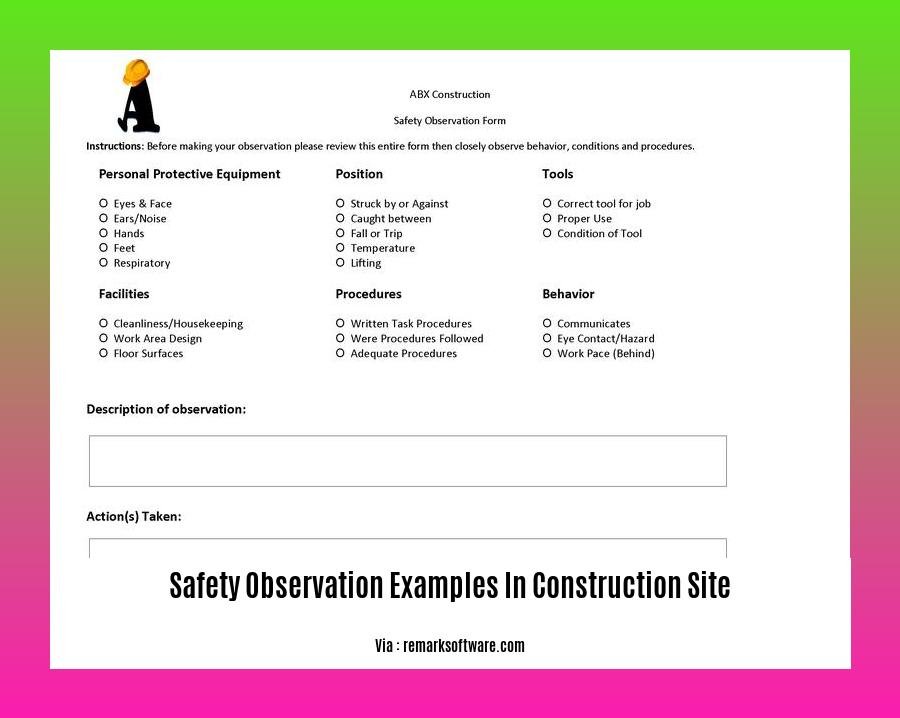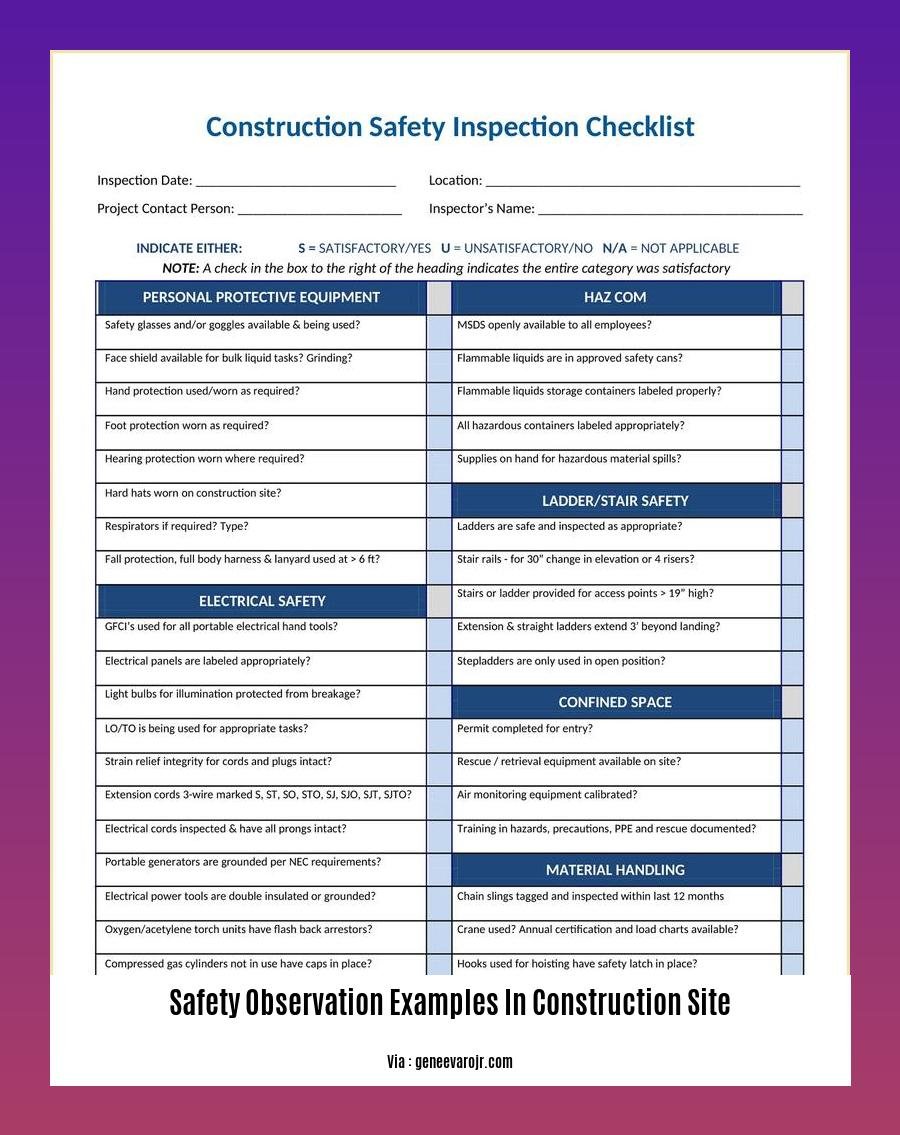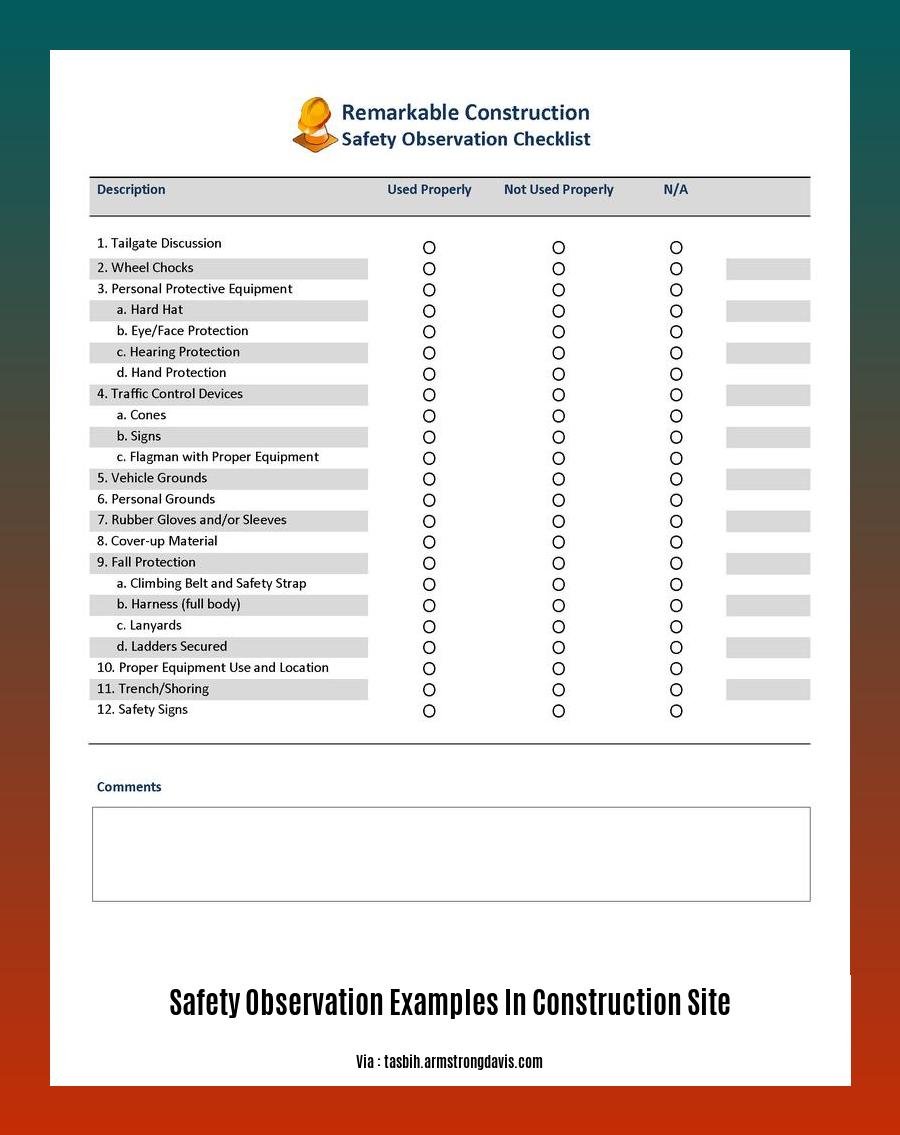Uncover the secrets of effective safety observation in construction with our comprehensive guide, [Comprehensive Guide to Safety Observation Examples in Construction Site].
Key Takeaways:
- Monitor noise levels to prevent hearing damage.
- Check ventilation to reduce exposure to hazardous substances.
- Assess ergonomics to prevent repetitive stress injuries.
- Ensure proper PPE usage to protect workers’ safety.
- Inspect ladders for safe placement and footing.
- Focus on electrical safety through grounding, insulation, and proper equipment use.
- Communicate potential hazards clearly to minimize exposure.
- Ensure fire safety measures are in place, such as extinguishers and evacuation plans.
- Observe excavation safety practices to prevent cave-ins and falls.
- Inspect equipment for defects and ensure safe operation.
- Implement safe material handling practices to prevent lifting-related injuries.
Safety Observation Examples in Construction Site

Hazard Identification:
– Inspect for uncovered electrical wires, poor lighting, or damaged insulation to prevent electrical shocks or fires.
– Note blocked or slippery walkways, uneven surfaces, or inadequate handrails to avoid slips, trips, and falls.
– Identify unsafe material storage practices, such as unstable stacks or unsecured loads, to prevent collapse or material-handling accidents.
– Observe workers’ body mechanics, including lifting techniques, to prevent musculoskeletal injuries.
Safe Work Practices:
– Ensure proper use of personal protective equipment (PPE), such as hard hats, safety glasses, gloves, and harnesses.
– Verify that ladders and scaffolding are stable, secured, and used correctly to prevent falls.
– Check excavations for proper shoring, barricading, and safe access to avoid cave-ins.
– Monitor heavy equipment operation for adherence to safe operating procedures and proper use of safety features.
Compliance with Regulations:
– Inspect for compliance with noise level limits to protect workers’ hearing.
– Check that ventilation systems are functioning effectively to prevent exposure to harmful fumes or dust.
– Ensure hazard communication is clear and accessible, including proper labeling and safety data sheets.
Training and Education:
– Observe workers’ understanding of safety policies and procedures to identify areas for improvement.
– Note specific behaviors that demonstrate safety awareness, such as reporting hazards or intervening in unsafe situations.
– Assess the effectiveness of safety training programs by observing workers’ application of safety knowledge.
Continuous Improvement:
– Regularly conduct safety observations to identify trends and patterns in potential hazards.
– Use observation data to develop targeted interventions and improve safety programs.
– Encourage worker participation in safety observations to foster a culture of safety awareness.
Stay up-to-date with the latest practices and regulations in the construction industry, such as safety issues in construction industry, safety nets for construction sites, safety officer construction job description, and safety officer duties and responsibilities in construction. Click to learn more!
Hazard Identification and Risk Assessment

In the realm of construction safety, hazard identification and risk assessment are paramount to preventing accidents and ensuring a safe work environment. Let’s unravel these essential concepts and their practical applications:
Hazard Identification
Hazard identification is the process of recognizing potential hazards in the workplace that could cause harm to workers. It’s like being an eagle-eyed detective, scanning the site for risks that might lurk in the shadows. Common construction hazards include:
- Unprotected electrical equipment
- Inadequate lighting
- Slippery surfaces
- Unsafe material handling practices
Risk Assessment
Risk assessment takes hazard identification a step further by evaluating the potential severity and likelihood of hazards. It’s like a doctor weighing up the risks and benefits of a medical procedure. In construction, it involves considering factors such as:
- The probability of a hazard occurring
- The possible consequences of the hazard
- The adequacy of existing controls
Benefits of Hazard Identification and Risk Assessment
Harnessing the power of hazard identification and risk assessment yields tangible benefits for construction sites:
- Reduced incidents and injuries
- Lower insurance premiums
- Improved safety culture
- Enhanced productivity
Practical Implementation
To make hazard identification and risk assessment a workplace reality:
- Conduct regular site inspections with a keen eye for hazards.
- Establish a clear hazard communication system.
- Train workers to recognize and report hazards.
- Develop and implement risk control measures to eliminate or minimize risks.
Key Takeaways:
- Hazard identification is the foundation for proactive safety management.
- Risk assessment helps prioritize hazards and implement effective controls.
- Regular hazard identification and risk assessment create safer construction sites and protect workers.
Sources:
- SafetyIQ: Hazard Identification
- Occupational Safety and Health Administration: Safety Management – Hazard Identification and Assessment
Housekeeping and Debris Removal
Maintain a clean and organized worksite
- Regularly gather and remove debris to keep the site orderly.
- Plan for proper debris removal and disposal of scrap, waste, and surplus materials.
- Keep work areas and equipment clean to prevent accidents.
- Ensure passageways and access points are clear of obstructions.
- Secure loose or light materials stored on roofs or open floors to prevent falling hazards.
Promote safety through good housekeeping
- Identify and report hazards to maintain a safe work environment.
- Encourage a tidy workplace to reduce accidents.
- Ensure proper disposal of hazardous waste.
Key Takeaways:
- Keep work areas clean and free of debris.
- Plan for proper waste and surplus material disposal.
- Maintain clear passageways and access points.
- Secure loose materials to prevent falling hazards.
- Promote a tidy and safe work environment.
Citations:
- Workplace Housekeeping – Checklist for Construction Sites
- Good Housekeeping Rules For A Tidy Construction Site
Working at Heights
Key Takeaways:
- Inspect fall protection equipment: Ensure proper usage and compliance with safety standards.
- Check scaffoldings and ladders: Verify stability, load capacity, and proper setup.
- Observe workers’ positioning and movement**: Ensure they maintain a safe distance from edges and use appropriate ladders and equipment.
- Monitor hoisting and crane operations: Verify adherence to safety protocols for equipment and load handling.
- Provide proper training and supervision: Ensure workers are trained on fall hazards and have clear safety instructions.
Proper safety observations are crucial when workers are working at heights. By implementing effective observation practices and addressing potential hazards, construction professionals can prevent accidents and protect worker safety.
FAQ
Q1: What are some common safety observation examples in construction sites?
Q2: Why is it important to conduct safety observations on construction sites?
Q3: What are the different types of safety observations that can be conducted on construction sites?
Q4: How can safety observations help improve safety conditions on construction sites?
Q5: What are some tips for conducting effective safety observations on construction sites?
- How to Clean WeatherTech Mats: The Ultimate Guide for a Spotless Car - April 20, 2025
- How to Clean Poop Out of Carpet: A Step-by-Step Guide - April 20, 2025
- How to Stop a Hardwired Smoke Detector from Chirping: Causes and Solutions - April 20, 2025










